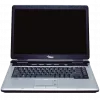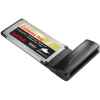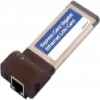ExpressCard is an interface to allow peripheral devices to be connected to a computer, usually a laptop computer. Formerly called NEWCARD, the ExpressCard standard specifies the design of slots built into the computer and of cards which can be inserted into ExpressCard slots. The cards contain electronic circuitry and connectors to which external devices can be connected. The ExpressCard standard replaces the PC Card (also known as PCMCIA) standards.
Hardware that may be plugged into a computer via an ExpressCard includes connect cards, IEEE 1394b-2002 (FireWire 800), USB 2.0, USB 3.0, Ethernet, Serial ATA external stick drives, solid-state drives, external enclosures for desktop size PCI Express graphics cards, wireless network interface cards (NIC), TV tuner cards, Common Access Card (CAC) readers, and soundcards.
The ExpressCard standard specifies two form factors, ExpressCard/34 (34 mm wide) and ExpressCard/54 (54 mm wide, in an L-shape)—the connector is the same on both (34 mm wide). Standard cards are 75 mm long (10.6 mm shorter than CardBus) and 5 mm thick, but may be thicker on sections that extend outside the standard form for Antennas, sockets, etc.
The 34 mm slot accepts only 34 mm cards. The 54 mm slot accepts both 34 mm and 54 mm cards. A diagonal guide in the rear of the 54 mm slot guides 34 mm cards to the connector. Adapters are available for connecting an ExpressCard/34 card to a CardBus (but not 16-bit PC Card) slot via internal USB2.0 bus only (not PCI-Express).
The ExpressCard 2.0 standard was introduced on March 4, 2009 at CeBIT in Hannover. It provides a single PCIe 1.0 2.5 Gbit/s lane (optionally PCIe 2.0 with 5 Gbit/s) and a USB 3.0 "SuperSpeed" link with a raw transfer speed of 5 Gbit/s (effective transfer speed up to 400 MB/s).[25][26] It is forward and backward compatible with earlier ExpressCard modules and slots. ExpressCard 2.0 products were expected to be in the market by late 2010. It's unknown at this point (October 2012) whether this standard is taking off in the marketplace.
USB 3.0 SuperSpeed compatibility is achieved by sharing the pins with the PCIe link. An inserted card signals which mode should be used.







